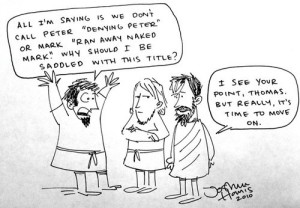I Need to Know
Sermon by Rev. Steven McClelland on John 20: 19 – 31. Focus on why Thomas and we need a bodily resurrection. Check out Jody Sinkway and the choir following the sermon.
It’s this simple and this bold. Without the bodily resurrection of Jesus Christianity would never have existed. No gospels, no Christians, no dark ages, no renaissance, no Galileo, Newton, no Michelangelo, Handel, Bach, Dylan, U2, no you, no me. All of Western civilization both it’s good and bad gone. Without this single event it would be as if someone came along with a huge eraser and swept away the past two thousand years.
Now if that’s hard to comprehend then I’ve done my job today. How do you comprehend the bodily resurrection of Jesus much less share that story with anyone else? That’s the task that Thomas’s story puts before us. How do we go out and share this good news?
That’s why I like Thomas. I can’t go out and offer good news if I haven’t experienced good news myself. And if you think that this means that he lacks faith then remember this. When Jesus went to raise Lazarus it was Thomas who said to all the others, “Let us also go, that we may die with him.” He knew, before any other disciple, what following Jesus really meant and he was willing to follow Jesus all the way.
And while we don’t know why Thomas wasn’t in the room with the other disciples. We know that he wasn’t hiding behind locked doors in fear with the rest of them. And he’s the only person in any gospel to ever understand and confess that when he stands before Jesus he stands before God himself. But still he’s criticized and known only as the doubting Thomas.
Well if it wasn’t for what Thomas wanted and got there would be no Gospels, no Christians, no way of knowing what God wants from us as human beings, no life after death. So the bodily resurrection is very important to us.
But because of its’ one of a kind nature it’s hard to explain so there’s been this recent trend in Christianity to speak about the resurrection in ways that don’t take the bodily part of it into account.
Many of them creative, well intentioned, but all misguided attempts to make the bodily resurrection something that can fit our understanding of it, and all of them will fail, because the resurrection by its very nature is an exploding of conventional categories, the ultimate disruption of what we think is real.
According to Biblical scholar Norman Perrin: “What actually happened on that first Easter morning … is that it became possible to know Jesus as ultimacy in the historicity of the everyday.” What?
In Psychologist Gerd Lunderman book – What Really Happened to Jesus, he writes: “The resurrection was Peter’s attempt to over come a severe guilt complex that he had over denying Jesus.”
Robert Funk says in his book – Honest to Jesus – “To claim that Jesus rose from the dead is a way of confessing that Jesus… caught a glimpse of eternity. Affirmations of Jesus’ resurrection should send his devotees searching through his parables and aphorisms for traces of that glimpse.”
And in Bishop Spong’s book – Resurrection: Myth or Reality? He writes: “The essence of the resurrection was Peter’s experience of seeing Jesus as the in breaking reality of God.”
The story of Thomas and the risen Christ ought to remind these scholars that their work is not what Thomas wanted or got from Jesus. He wanted and got a bodily resurrection.
I’ll conclude with this story. A bunch of us were having a discussion on things that are hard to explain in the Bible. And in due time, someone mentioned the difficulty of believing in the bodily resurrection of Jesus. It was especially hard to believe in, for those who were rock solid in understanding the world through logic and reason. And they made a good point that it’s never happened since. Maybe life after death, but a dead body raised from a tomb? How can that be credible?
A woman in the group spoke up, “Well, I do believe in the resurrection. I’ve seen it. I’ve lived it. When my husband walked out on me, I could have died. I did die. My life was over. Dead end.
But then, by the grace of God, and with the coaxing of good friends, I came back. I came back to life. I got a whole new life. It was a miracle.”
Then she said, “I believe in the resurrection. I’ve lived it.”
And so have we. Every time we take someone’s hand as we exchange the Peace of Christ, we touch the risen, living body of Christ. And we know this to be true because besides touching hands we also touched each other and shared in each other’s joys and tragedies. We’ve prayed for one another and given thanks together for the joys of births, anniversaries and answered prayers. We’ve experienced it in the meals we’ve shared both in homes and at church. We experienced in the events we’ve sponsored and the lives we’ve helped with our donations of food, diapers and dollars.
That’s what it’s all about. It’s about the incarnation. God becoming one of us in the flesh so that God could resurrect all of us. The good news is that we can leave the rooms of fear and doubt that have locked us in and go out emboldened by the knowledge that we bear the peace, purpose and power of the one who has born all of our pain and proclaim with Thomas “My Lord and my God. Jesus once dead and buried is raised, so that you and I might rise, so that we can offer the hope that others will rise too. Amen

